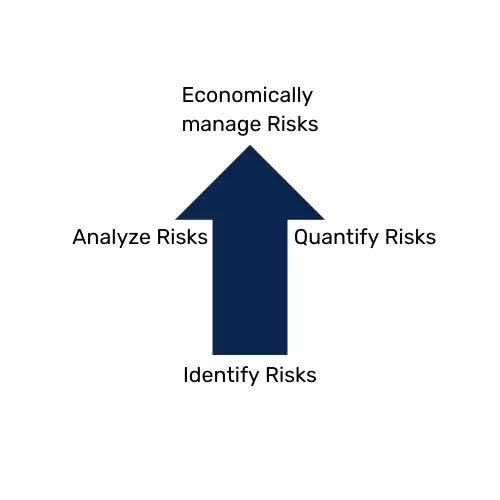What is Risk Management?
Every organisation irrespective of size and business face risks. Depending upon the business, there is a degree of chance of a risk causing huge strain on the finances, leading to its end.
For e.g. a mobile app development company Madan Co starts from a small 1 room office with 4 staff and a major telecom customer. The sales income shoots to Rs 25 Cr in just 2 years and Rs 15 Cr profit. Their assets are just 3 computers, its 10 employees, a cloud storage, a few subscriptions to development apps and a small office. They felt there is no insurance required, as their intellectual capital is in cloud, except Rs 50 Lakhs of office cost and Rs 7 L of 10 computers/air-conditioners. Even a fire accident could not have an impact more than 7 days on this company, they prided.
Madan Co got hit by a road accident, where the owner and 4 of the executives were severely injured. Their turnover plummeted to Rs 5 Cr in next 1 year. No doubt a group accident policy and a group Mediclaim policy could have helped to overcome a part of their loss and quickened their healing in best hospitals. A risk analysis could have also shown that big companies would not have allowed such a travel of key executives together in a vehicle or air or other modes.
A hair cutting saloon which makes Rs 3 Lakhs a month could similarly be hit by a fire and lose all their equipment and lose Rs 25 L over 6 months. They may close the business as they do not capital to re-invest, in the absence of proper insurance. The owner Mahesh realised that risk management is not a luxury for big companies. When Mahesh and his wife started a beauty parlour after a year with some loans from family & friends, they changed their attitude towards risks in small businesses and managed their risks better.
Risk Management comes as a set of indispensable tools to manage risks which are preventable as well as unavoidable. Process of Risk Management involves Identifying, Assessing/Analysing, Evaluating/Quantifying and ‘Economic’ Management of Risks so Identified.
This set of tools helps you act in time on the risks which prevent the organisation from fulfilling its objectives, as you saw above in Madan Co or Mahesh’s hair style joint.
Many think Enterprise Risk Management (ERM) is complicated and needs lot of time to invest and is not worthwhile. Mahesh and his wife found it is just a culture and just requires a few hours a week. They used their free times on weekly-off days and off-business hours with their Admin girl to review steps needed/lessons learnt.

Following are important components of Risk Management:
Risk Identification: First step of the Risk Management process is to identify potential threats to the organisation. The identification process is of paramount importance as leaving unidentified risks can cause severe damage to the finances and reputation of the company. Many businesses, no doubt attempt this step, but fail sometimes due to lack of systematic, fool-proof and honest attempts in this identification phase. For big risks, there are tools available.
Risk Analysis: Once risks are identified, each one of them should be categorised based on their occurrence and severity as follows:
The most important part of analysis is to identify a owner-a full time executive within the Company, who is responsible for the risk! Otherwise the exercise may not bear fruit. Even for Madan Co example, the owner should have assigned responsibility even if the risks identified were just 5.
Economic Risk Management: Risks although cannot be completely eliminated, can be controlled to an extent at a cost. This cost has to be economic to be justified in a budget. Some entrepreneurs might either choose not to incur such cost and expose themselves. The prudence test comes in here! Mahesh found a premium of Rs 75,000 high for his saloon and you saw how he suffered above.
A register is to be prepared by the responsible business owner(s) through his people, called Risk Register. This register should contain the threats, severity, frequency and mitigation required and costs associated. This comprehensive register helps the organisation keep track of all the risks they are exposed to and control them accordingly.
There are some risks which can be managed only through non-insurance options. Examples are transfer of risks by a construction contractor to the Building Owners, who have a deeper packet! Another example is setting up a ‘catastrophe fund’ to create huge sum over, say, 5-7 years, to meet business closure risks. This applies to small & big enterprises.
EXEMPLARY feedback from industry leaders






EXPERIENCES shared by our students
the nuances of corporate insurance
your knowledge by staying updated